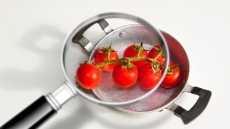UK food scientists analyse acrylamide tools for food industry
at analytical methods currently used by the food industry to
monitor the formation of acrylamide during the heat treatment of
potato and cereal based food products.
Acrylamide hit the headlines in 2002, when scientists at the Swedish Food Administration first reported unexpectedly high levels of acrylamide, found to cause cancer in laboratory rats, in carbohydrate-rich foods, such as crisps, cooked at high temperatures.
Since the Swedish discovery a global effort has been underway to amass data about this chemical. More than 200 research projects have been initiated around the world, and their findings co-ordinated by national governments, the EU and the United Nations.
Recent findings, propelled by UK scientist Professor Don Mottram at the University of Reading, suggest that the free amino acid asparagine, found naturally in potatoes and cereals, could play a key role in the formation of acrylamide.
Tests show that when the amino acid is heated, it does react with sugar to create acrylamide, a process called the Maillard reaction.
In a paper published in the Journal of Agricultural and Food Chemistry David Cook and Andrew Taylor from the Division of Food Sciences at the UK's University of Nottingham outline a host of analytical methods currently used by scientists to track acrylamide formation.
For the current paper by Cook and Taylor, 13C-labelled acrylamide was used as a marker to calibrate the partition of acrylamide during on-line analysis by atmospheric pressure chemical ionisation mass spectrometry (APCI-MS), reports RSSL.
On-line results at 180 oC were compared with similar data from GC-MS analysis. Temporal profiles of acrylamide generation for the APCI-MS and GC-MS were similar, as were the determined amounts of acrylamide formed in the potato, rye and wheat.
Suggesting market opportunities for European suppliers of citric acid - currently under pressure from Chinese suppliers - and soy protein hydrolysate, the UK scientists investigated the effects these ingredients could have on the formation of acrylamide.
The results confirmed earlier studies suggesting that such additions could reduce acrylamide formation.
The report authors warn however that the addition of citric acid and soy protein hydrolysate addition could also alter the course of the Maillard Reaction, as well as having an impact on the ultimate flavour and colour of the food formulation.
A copy of the European food and drink industry's document on acrylamide can be found at: www.ciaa.be.






















